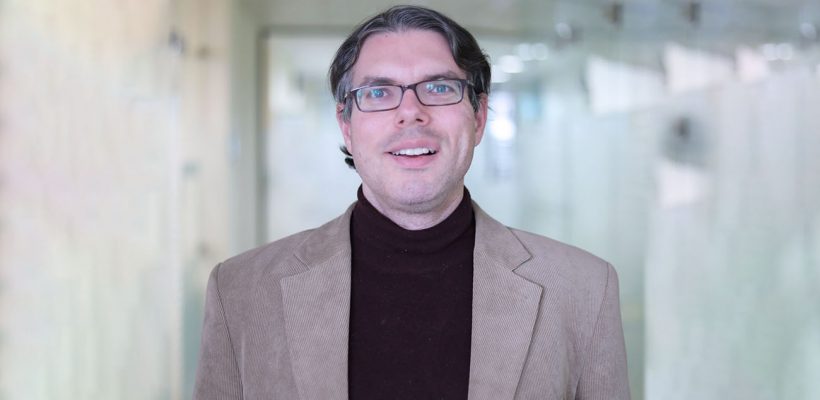
International Faculty Spotlight: Dr. Mica Hilson
4 min readDr. Hilson moved to Armenia from the U.S. four years ago to teach at the American University of Armenia (AUA). He reflects on his journey before Armenia and shares with us his experience as an associate professor in the College of Humanities & Social Sciences (CHSS).
Tell us about your academic background. What led you to your profession? Did you always know that you wanted to teach?
I was homeschooled for the first few grades, and my mother’s empathetic and patient teaching style made a huge impression on me. I went to university very young, celebrating my 15th birthday in the dorm during Freshman Orientation. Even then, I knew I wanted to teach, but I wasn’t sure what subject I would want to teach. By the time I was 16 years old, I had four teaching jobs simultaneously — serving as a writing tutor, a math tutor, a chemistry teaching assistant, and a chemistry lab assistant. By the time I graduated Emory University at 18, I figured out that English was my true passion. So I took a gap year and taught English language at a high school in the Czech Republic, and then returned to the United States to complete my PhD.
You have been at the American University of Armenia (AUA) for about four years. What initially brought you to AUA? How have your perceptions of Armenia and its youth evolved since you first arrived?
I knew about AUA from a friend I made in graduate school, Sos Baghramyan, who was one of the first faculty members AUA hired when the undergraduate E&C program was launched in 2013. (Incidentally, Sos is teaching a special topics class in Shakespeare for AUA next semester, and all E&C Juniors and Seniors should sign up to take it if they haven’t already, because he’s a brilliant Shakespearean scholar). In late 2015, I was at an impasse in my career. I was teaching at a university in South Carolina that I liked, but the position didn’t offer me much room for advancement. When perusing academic job websites, I saw that AUA had an opening, and called Sos to get more details. I’m glad I did, because this was the best professional decision I’ve ever made. Once I got the job offer, I moved to Armenia, a country I had never even visited; in fact, I had never traveled further east than Istanbul.
I didn’t know precisely what to expect when I moved here, although the city of Yerevan looked beautiful when virtually walking down Baghramyan Avenue on Google Street View. I was especially worried that there might be some serious cultural misunderstandings between my students and me. I wondered whether they’d understand my jokes and if we’d have any common cultural references that would help us to communicate. To my surprise, what I discovered is that I actually had much more in common with the students at AUA than I did with most of the students I taught in South Carolina (just three hours away from my hometown). AUA students tend to be avid readers, and you can’t overestimate just how much those interests in books, culture, and ideas bind people together.
As I’ve continued teaching at AUA for the past four years, I’ve gotten to see even more sides to my students. I’ve gotten to see students I taught as Freshmen develop a new sense of maturity and purpose. I’ve also gained a better understanding of where my students are coming from, in terms of both the cultural pressures they face and their dreams for a brighter future. And of course the steps that many of my students took towards building that better future in the 2018 Velvet Revolution made me very proud.
Tell us about your experience as an AUA faculty member. How does it differ from your experience at universities in the U.S.?
AUA is pretty unique, in that there’s a clear sense of shared purpose. Although we welcome students from all over the world, we want to improve Armenia and provide more opportunities to Armenian students. One of the main reasons I love teaching here is that I often get the chance to help students who are brilliant and highly motivated, but need my support and expertise in order to become very successful in their fields. I didn’t often encounter students like that when I taught at universities in the United States; more often, I’d either teach very privileged students who didn’t need my help to succeed or less ambitious students who didn’t need my help to attain their modest career goals.
What do you enjoy most about teaching? What impact do you aim to have on your students?
One of the things I love about teaching at AUA is that I get to know each E&C student as an individual, and I will often get to teach them in multiple courses over their four years here. I especially love getting to teach most of our first-semester students in Introduction to Communications. It’s a challenging course that really dumps students in the “deep end of the pool” with a lot of reading and writing assignments, but I make sure to provide them with plenty of support, while conveying my own enthusiasm for the material. And sure enough, by the end of the semester, I can see a huge difference in my students’ speaking, writing, and critical thinking abilities.
Similarly, I love working with our fourth-year students on their capstone projects. We give them a lot of room to design research projects or creative projects that fit their individual interests, and I get to work with them one-on-one to facilitate those projects. Because our students have such diverse interests, it’s like teaching 15-20 unrelated independent study courses each spring. But it’s worth it, because at the end of the year, students end up doing these phenomenal projects they would have never been able to accomplish without an AUA education.
